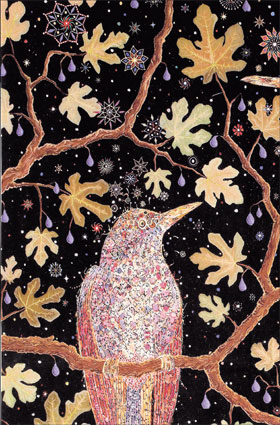 |
|
"After Migrant Fruit Thugs" by Fred Tomaselli on display at SHContemporary
|
This is a tough year for the arts and art fairs. Shanghai's two major art fairs opening today are struggling to survive and make money in the economic downturn by reinventing themselves.
With fewer foreign galleries participating, Shanghai Art Fair and ShContemporary have invited more domestic galleries. They are emphasizing Asian art, especially Chinese art, and trying to nurture a new generation of Chinese collectors and a public who appreciates contemporary art.
There's an old Chinese saying that applies here, of course: "When there's no light in the East, there will be light to the West." Interpreting that truism today means it's time to look to the East, which is weathering the downturn better than other regions.
There's behind-the-scenes talk that SHContemporary, which made a big splash when it was launched in 2007, may not be able to continue after this year.
Both fairs run through Sunday, SHContemporary at ShanghaiMart, Shanghai Art Fair at Shanghai Exhibition Center.
Just a few years ago the contemporary Chinese art market was sizzling and few could foresee what's been called the "cold wintertime" caused by the global economic downturn.
In the summer of 2007, the just-launched SHContemporary boasted that it was Asia's biggest and best art fair. Hopes were high that the successful event in Shanghai signaled good times and prosperity.
The opening at Shanghai Exhibition Center was thronged and everyone was chatting excitedly about the bright future.
Shanghai Art Fair, a local event that started in 1996, was another triumph for years. Many major Western art figures - artists, collectors, galleries - made a point of attending, though the show was not well known in the West.
When art fever was at its peak, first-class flights from major Western cities to Shanghai were fully booked as collectors, dealers and gallery owners rushed to the city.
The bubble burst.
"If I said nothing had changed, I'd be lying," says Wang Anwei, spokesman for Shanghai Art Fair. "But we wracked our brains to figure out how to hold a good fair.
"Not enough overseas galleries are coming this year, so we are attracting more domestic galleries," says Wang. Of the 126 participating galleries, 96 are domestic. The fair this year still covers 24,000 square meters at ShanghaiMart.
Last year more than 140 galleries attended the fair and around half were foreign.
The shrinking number of galleries is also a headache for SHContemporary.
The official Website of SHContemporary says 75 galleries are participating, but only 20 of them are from Europe and America. The number of participating galleries last year has almost doubled this year, it says.
Now it aims to promote art from Asia where the economic downturn has not been as severe as in the West.
"We made a big adjustment," says Xiao Ge, spokeswoman for SHContemporary.
Both the Shanghai Art Fair and SHContemporary are struggling to survive, relying mainly on financial power in the East.
"It's time for more people to recognize the value of Chinese traditional culture," says Wang of Shanghai Art Fair. "After all, it is the solid base of any further development of Chinese art."